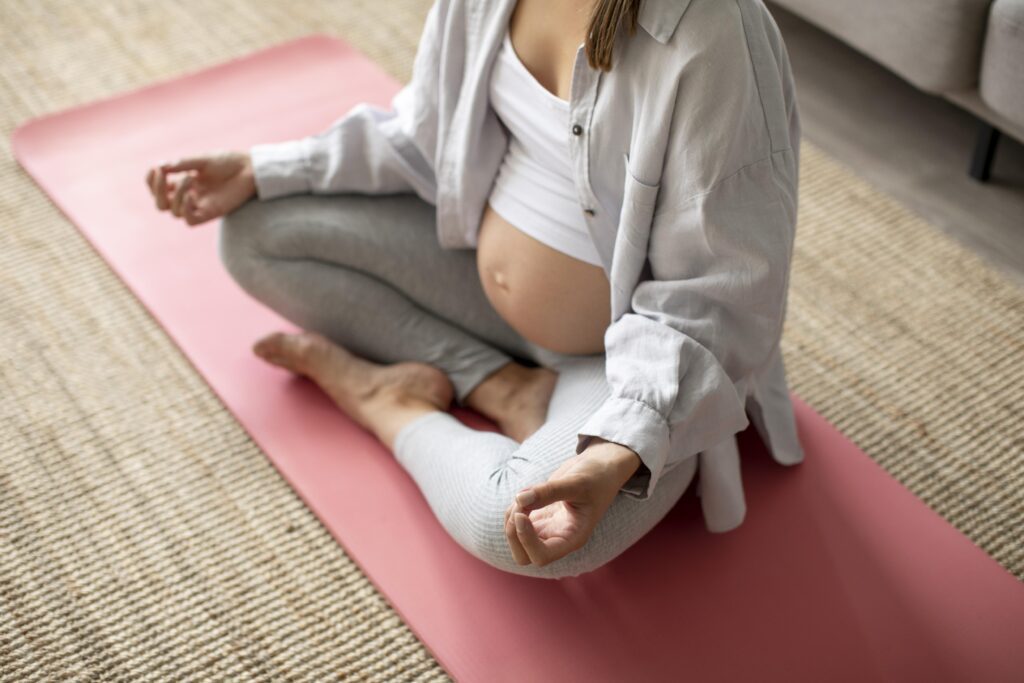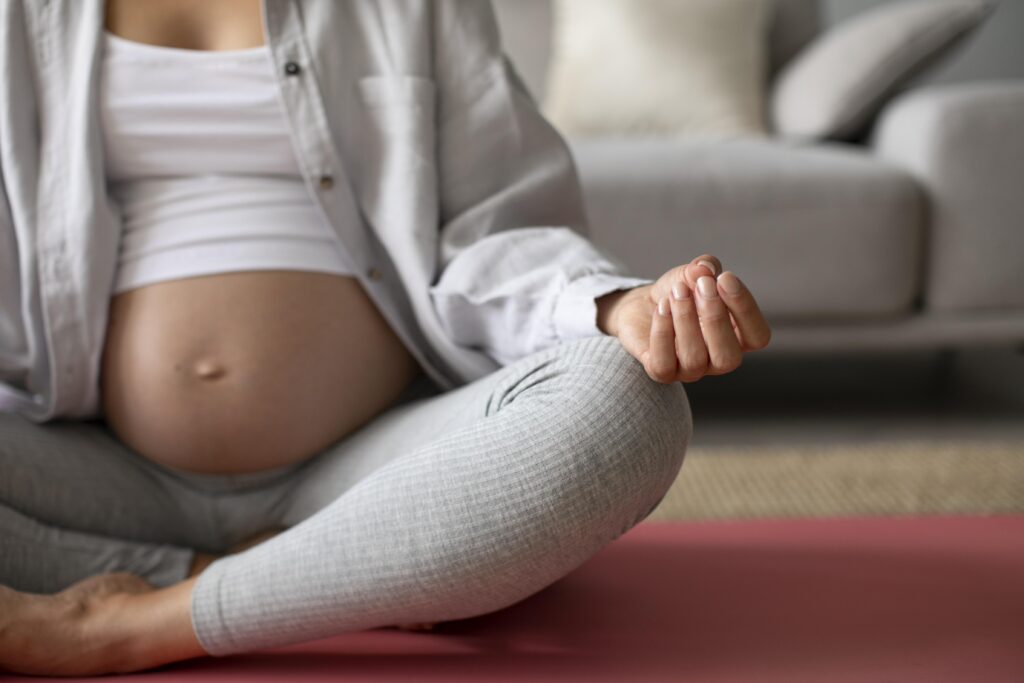During your pregnancy, one of the most annoying symptoms that appears may be that you have trouble sleeping or that you get up at night and never sleep again. Today from mamayoga We explain 5 yoga postures to relax before going to sleep.
Sleep and pregnancy
Irregular sleep can appear in any trimester of pregnancy, although it is more common from week 30 or around week 33. It is due to several factors such as the hormonal cocktail, the fact that your baby is very very active (with ninja kicks included), or also to the discomfort in finding a good posture, the need to go to the bathroom more frequently, or nighttime cramps, among others.
A healthy pregnancy consists of be physically active, eat healthy and, above all, get a good rest. So let's say these sleepless nights don't help.
If you are still working, not resting at night will make you feel defeated all day or fall asleep in any corner. So let's see how yoga can help you rest better at night.
Yoga before sleeping
The practice of yoga adapts to the time of day and also to our state at all times. The first thing in the morning practice will be the one that fills us with energy during our pregnancy and activates us for the whole day, while before going to sleep you can do a short practice that is very relaxing and focused on rest.
To promote good sleep and rest, we will look for yoga postures or a practice with the following objectives:
- Activate the parasympathetic system.
- Stretch and relax.
- Enter softness and rest.
- Relieve the typical discomforts of pregnancy.
We will therefore avoid very active practices or physical exercise after sunset, since they will fill you with too much energy and this will add to the fact that you will not sleep well. Of course, you can do them the rest of the day so that at night your body is more willing to take a break. A good activity routine during the day accompanied by stable schedules, such as going to sleep and always getting up at the same time, will align your activity and rest rhythms and thus you will sleep better.
Let's look at some examples of yoga postures to relax before going to sleep.
Ideal yoga postures before sleeping during our pregnancy
Cat-cow
We start with one of the queen yoga postures for pregnancy, ideal in any trimester and with multiple benefits. Practiced before going to sleep: relaxes the spine, mobilizes the joints, and in the variant that we explain below avoid annoying ramps.
Sit on the floor on all fours, that is, supported on your hands, knees and tips of your toes. When you inhale, raise your head and gaze toward the ceiling, expanding your torso but without letting the baby collapse downward. When you exhale you pick up the baby, the baby turns inward and the head falls, the hands press the floor and your shoulder blades stretch. Do it for 1 or 2 minutes, making sure your breathing is long and slow, there is no rush, enjoy the movement.
Afterwards, stretch your left leg backwards, resting the toes of your left foot on the floor with the heel facing the ceiling. Rock your body weight toward your heel several times to stretch your calf and leg. Repeat with the right leg.
The pigeon or the iguana
This position in its variant for pregnant women will help us to open the diaphragm, reposition the back and reduce sciatica discomfort.
Part of the cat-cow pose. Bend your left leg and bring your knee forward between your hands on the floor and stretch your right leg backwards on the floor, resting the toes of your right foot and heel raised (to avoid ramps). Lean on your hands, relaxing your shoulders down. The left foot can open from the side to the right so you have more space for you and the baby. When you inhale, raise your right arm up and back, opening your chest and heart; when you exhale, you lower it to the starting position. Inhaling, do the same with your left arm. Repeat each arm two or three times.
Finally, release yourself forward, resting your head on your fists on the floor. Hold for one minute to relax your lower back. Return to the cat-cow pose and repeat with your right leg forward.
legs on the wall
Another essential to close the day and rest is the inverted posture adapted from bringing your legs to the wall. It will help you unload your whole day, relieves tired legs, reduces swelling of ankles or feet, relieve pubalgia symptoms during pregnancy and also brings blood to the head to empty it of thoughts before sleeping.
You can use a blanket folded so that your hips are higher than your heart. Also some cushion on your head, especially if you have reflux or heartburn.
Sit on the wall on the blanket, on your side so that it is easy for you to turn when raising your legs. Raise your stretched legs up to the wall, letting your buttocks and lower back rest on the blanket and your entire back relaxed on the floor. If your legs are too far from the wall, walk with your buttocks until you are about two fingers away from touching it.
Bend your knees and rest your feet on the wall. With the force of your feet when you inhale, lift the baby towards the ceiling, when you exhale, return your back to the floor. Do it a few times and if you feel like it, stay a few breaths up, resting your hands on your back to support yourself better.
To close, open your arms crosswise on the floor, leave your back well supported on the floor with your legs on the wall on the blanket and rest for a few more minutes.
The shoemaker or the butterfly lying down
This yoga posture before sleeping leads us to deep rest and is also responsible for softening the hips, creating space for the baby and inviting you to enter the pause with deep breathing.
Although you can do it without material, its restorative variant with tape, blocks, blankets and cushions and an eye mask is total relaxation.
Sit on the floor with some cushions on your back so that you can lie on them and keep your trunk slightly elevated. Knees slightly bent and open towards the ground, soles of feet touching. You can place a tape that surrounds your lower back, passes inside your legs and groin, and surrounds your feet so you don't have to make any effort to maintain the opening. If the opening bothers you or you have knee pain, you can place a block on each leg near the buttock to prevent the legs from opening too much.
Once in the posture, cover your eyes with a mask or seed pad that smells like lavender. One hand rests on your heart and the other on the baby, the baby. Enjoy for five minutes taking long, calm and slow breaths, bringing the air towards the baby.
Hug the ball
Finally, if you have an exercise ball, or a large fitness ball, you can close with a very relaxing position, hugging the ball. This will help you go within, enter the natural rocking of your body for relaxation and also symbolically in cradling you and the baby, the baby.
Two options, sit on your knees or on your buttocks with your legs open, whichever is more comfortable for you. Hug the ball by wrapping your arms around it and resting your head on it. Let the ball swing gently from one side to the other in a movement that slowly and gently rocks your body. Let yourself be invaded by the tenderness of the movement, you can accompany it by singing the very serious “mmmmm” sound, making your lips, your chest, the ball and your entire spine vibrate.
Enjoy a few minutes.

Meditation for sleepless nights
Sa ta na ma
If despite everything you have one of the dreaded sleepless nights, don't worry, take the opportunity to connect with yourself and the baby with quiet meditations from the comfort of bed. We explain one of them to you to see if it works for you, the “Sa ta na ma” meditation.
It is a mantra from the tradition of kundalini yoga which is used for emotional balance. It is made up of four seed sounds or bijamantras: sa the totality, the beginning and the end, ta existence and life, na The transformation, ma the rebirth from joy. So we could say that it is the acceptance of the cycle of life and that everything changes.
There are many versions of the mantra, we especially like the version performed by Mirabai Ceiba. You can listen to it before to incorporate the melody for when you need it.
With your dominant hand, you will run your thumb over the rest of your fingers while you mentally recite the mantra. Index finger “sa”, middle finger “ta”, ring finger “na” and little finger “ma”. As follows:
- First 5 or 6 laps putting pressure on each finger.
- The next 5 or 6 laps, bringing your fingers together but without touching.
- The last 5 or 6 laps without moving your fingers, mentally.
After that, rest for a few minutes listening to your calm and natural breathing.
We hope that these exercises and recommendations can help you relax through yoga, its postures and meditations before going to sleep during those months of pregnancy.
Silvia Gallego
Author and editor, prenatal yoga teacher




